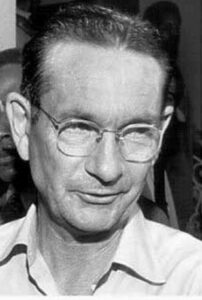 Byron De La Beckwith Jr. (November 9, 1920 – January 21, 2001), was a Marine veteran, a white supremacist, and a member of the Ku Klux Klan. He assassinated civil rights leader Medgar Evers on June 12, 1963. In 1964, he was tried twice by all white male juries on murder charge in Mississippi. Each trial ended in ended in a hung jury, and De La Beckwith went free. In 1994, based on new evidence, he was tried and convicted of murder and sentenced to life in prison.
Byron De La Beckwith Jr. (November 9, 1920 – January 21, 2001), was a Marine veteran, a white supremacist, and a member of the Ku Klux Klan. He assassinated civil rights leader Medgar Evers on June 12, 1963. In 1964, he was tried twice by all white male juries on murder charge in Mississippi. Each trial ended in ended in a hung jury, and De La Beckwith went free. In 1994, based on new evidence, he was tried and convicted of murder and sentenced to life in prison.
Medic has obtained Beckwith’s military records from the National Personnel Records Center. In World War II Beckwith served in the Marine’s and saw heavy combat in the Pacific theater. Noteworthy are his wounds, his various requests to attend flying school, a handwritten letter requesting his awards and decorations, and other official correspondence.
File 1, File 2, File 3, File 4, File 5, File 6, File 7, File 8, File 9, File 10.
An only child, both parents dead before he was twelve, Byron De La Beckwith was raised by an uncle and his wife. They supported his studies at the prestigious Webb School, in Bell Buckle, Tennessee.
In January 1942, De La Beckwith enlisted in the Marines. He served as a machine gunner in the Pacific theater and fought in the Battle of Guadalcanal. He was wounded at the Battle of Tarawa. Honorably discharged in August 1945, the newly married De La Beckwith moved to Providence, Rhode Island. He eventually divorced his wife, remarried, and settled in Mississippi.
De La Beckwith worked as a salesman, selling tobacco, fertilizer, wood stoves, and other goods. In 1954, following a Supreme Court ruling that segregated public schools were unconstitutional, he joined the White Citizens’ Council and the Ku Klux Klan, both of which opposed desegregation and intimidated African Americans working for civil rights.
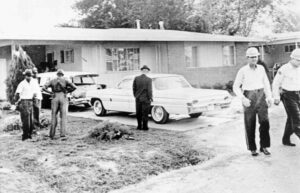 On June 12, 1963, the 42 year old De La Beckwith murdered NAACP and civil rights leader Medgar Evers. That night, De La Beckwith positioned himself across the street from Evers’s house, waited for him to return home, and shot him in the back. Evers, the first NAACP field secretary in the state, died an hour later. He was 37 years old. Myrlie Evers, his wife, and his three children were home at the time Evers was killed. His son Darrell recalled: “We were ready to greet him, because every time he came home it was special for us. He was traveling a lot at that time. All of a sudden, we heard a shot. We knew what it was.”
On June 12, 1963, the 42 year old De La Beckwith murdered NAACP and civil rights leader Medgar Evers. That night, De La Beckwith positioned himself across the street from Evers’s house, waited for him to return home, and shot him in the back. Evers, the first NAACP field secretary in the state, died an hour later. He was 37 years old. Myrlie Evers, his wife, and his three children were home at the time Evers was killed. His son Darrell recalled: “We were ready to greet him, because every time he came home it was special for us. He was traveling a lot at that time. All of a sudden, we heard a shot. We knew what it was.”
The state prosecuted De La Beckwith twice for murder in 1964. Since Mississippi’s disenfranchisement of black voters meant they were excluded from serving on juries, both trials ended with all white hung juries. During the second trial, Mississippi Governor Ross Barnett, a Democrat, shook hands with De La Beckwith in the courtroom. The White Citizens’ Council paid all De La Beckwith’s legal expenses.
In January 1966, De La Beckwith, along with a number of other Klan members, was subpoenaed 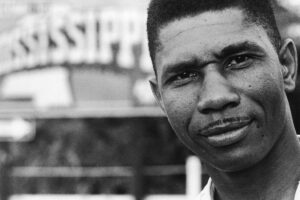 by the House Un-American Activities Committee to testify about the Klan. Although he gave his name he answered no other substantive questions. In the following years, De La Beckwith became a leader in the segregationist Phineas Priesthood, an offshoot of the white supremacist Christian Identity movement. The Priesthood was known for its hostility toward Blacks, Jews, Catholics, and foreigners.
by the House Un-American Activities Committee to testify about the Klan. Although he gave his name he answered no other substantive questions. In the following years, De La Beckwith became a leader in the segregationist Phineas Priesthood, an offshoot of the white supremacist Christian Identity movement. The Priesthood was known for its hostility toward Blacks, Jews, Catholics, and foreigners.
In 1967, De La Beckwith unsuccessfully sought the Democratic Party’s nomination for Lieutenant Governor of Mississippi. In 1969, De La Beckwith’s previous charges were dismissed. In 1973, informants alerted the FBI that he planned to murder A.I. Botnick, director of the New Orleans-based B’nai B’rith Anti-Defamation League, for comments Botnick made about white Southerners and race relations.
Following several days of surveillance, New Orleans Police Department officers stopped De La Beckwith as he was driving on the Lake Pontchartrain Causeway Bridge to New Orleans. Among the contents of his car were several loaded firearms, a map with highlighted directions to Botnick’s house, and a dynamite time bomb.
On August 1, 1975, De La Beckwith was convicted in Louisiana of conspiracy to commit murder and sentenced to five years in prison. After losing his appeal, he was detained in Washington, D.C. for failing to report to prison. De La Beckwith served nearly three years of his sentence at Angola Prison in Louisiana and was paroled in January 1980. Just before entering prison De La Beckwith was ordained by Reverend Dewey “Buddy” Tucker as a minister in the Temple Memorial Baptist Church, a Christian Identity congregation in Knoxville, Tennessee.
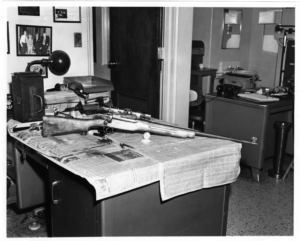 In the 1980s, the Jackson Clarion-Ledger published investigative reports by Jerry Mitchell on De La Beckwith’s trials in the 1960s. Mitchell found that the Mississippi State Sovereignty Commission had assisted De La Beckwith’s attorneys by illegally investigating the jury pool to aid the defense in picking a sympathetic jury. Armed with this evidence, Medgars’ widow, who later became the third woman to chair the NAACP, pressed authorities to reopen the case. These findings and other evidence would contribute to the state conducting the third trial of De La Beckwith in 1994.
In the 1980s, the Jackson Clarion-Ledger published investigative reports by Jerry Mitchell on De La Beckwith’s trials in the 1960s. Mitchell found that the Mississippi State Sovereignty Commission had assisted De La Beckwith’s attorneys by illegally investigating the jury pool to aid the defense in picking a sympathetic jury. Armed with this evidence, Medgars’ widow, who later became the third woman to chair the NAACP, pressed authorities to reopen the case. These findings and other evidence would contribute to the state conducting the third trial of De La Beckwith in 1994.
Now 71 and living in Walden, Tennessee, De La Beckwith was extradited to Mississippi to face trial in Jackson. The Mississippi Supreme Court denied his request to dismiss the case on the grounds that it violated his rights to a speedy trial, due process, and protection from double jeopardy.
During the trial, when the murder weapon, an Enfield .30-06 caliber rifle, with De La Beckwith’s fingerprints, was presented at trial, De La Beckwith claimed the gun was stolen from his house. He also cited his high blood pressure, lack of energy and kidney problems. “I need a list to recite everything I suffer from, and I hate to complain because I’m not the complaining type.”
According to Delmar Dennis, a key witness for the prosecution, in the years following his mistrials De La Beckwith boasted of his role in the death of Medgar Evers at several Ku Klux Klan rallies and similar gatherings.
On February 5, 1994, a jury composed of eight African Americans and four whites, convicted De La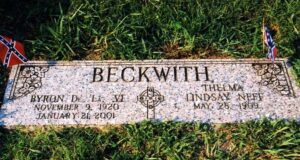 Beckwith of murder. He was sentenced to life. De La Beckwith appealed. In 1997 the Mississippi Supreme Court upheld the conviction. The court said that the 31-year lapse between the murder and conviction did not deny the defendant a fair trial.
Beckwith of murder. He was sentenced to life. De La Beckwith appealed. In 1997 the Mississippi Supreme Court upheld the conviction. The court said that the 31-year lapse between the murder and conviction did not deny the defendant a fair trial.
On January 21, 2001, De La Beckwith died after he was transferred from prison to the University of Mississippi Medical Center in Jackson, Mississippi. He was 80 years old.
______________
Top photo: Byron De La Beckwith, Jr. of Greenwood, Mississippi, smiles as he awaits the verdict in his trial in New Orleans on a federal firearms violation. Police said they found a ticking timebomb in Beckwith’s car while arresting him in September as he entered New Orleans. Police said Beckwith was headed for the home of a leader in the New Orleans Jewish community when they arrested him. Beckwith was tried twice in 1964, but not convicted, for the 1963 murder of black Civil Rights leader Medgar Evers. Photo credit: Benton Museum of Art, Pomona College, Restricted gift of Michael Mattis and Judy Hochberg in honor of Myrlie Evers-Williams.
Sources
Wikipedia
Jerry Mitchell,
The Case of the Supposedly Sealed Files—And What They Revealed
An article on murdered civil rights activists Casey/Schwarmer/Goodman, and De La Beckwith
New York Times
the obituary of Byron De La Beckwith
Ghosts of Mississippi
A 1996 film about the murder and 1994 trial. James Woods portrayal of De La Beckwith was nominated for an Academy Award.
The Last White Knight (documentary)
43 years after being assaulted by Del La Beckwith civil rights activist Paul Saltzman meets with him for a remarkable conversation about American race relations.
Where Is the Voice Coming From?
A short story by Eudora Welty. Published in The New Yorker on July 6, 1963. Welty, from Jackson, Mississippi, later said: “Whoever the murderer is, I know him: not his identity, but his coming about, in this time and place. That is, I ought to have learned by now, from here, what such a man, intent on such a deed, had going on in his mind. I wrote his story—my fiction—in the first person: about that character’s point of view.” The story, published before De La Beckwith’s arrest, was so accurate in its portrayal that for legal reasons the editors changed several details before publication.
Suggested reading
Never Too Late, A Prosecutor’s Story of Justice in the Medgar Evers Trial, by Bobby DeLaughter
Reena Evers-Everette, I Watched My Fater Medgar Evers Die, But You Cannot Kill His Ideas
Medgar Evers military records and bio on Medic in the Green Time

Byron De La Beckwith
Medic has obtained Beckwith’s military records from the National Personnel Records Center. In World War II Beckwith served in the Marine’s and saw heavy combat in the Pacific theater. Noteworthy are his wounds, his various requests to attend flying school, a handwritten letter requesting his awards and decorations, and other official correspondence.
File 1, File 2, File 3, File 4, File 5, File 6, File 7, File 8, File 9, File 10.
An only child, both parents dead before he was twelve, Byron De La Beckwith was raised by an uncle and his wife. They supported his studies at the prestigious Webb School, in Bell Buckle, Tennessee.
In January 1942, De La Beckwith enlisted in the Marines. He served as a machine gunner in the Pacific theater and fought in the Battle of Guadalcanal. He was wounded at the Battle of Tarawa. Honorably discharged in August 1945, the newly married De La Beckwith moved to Providence, Rhode Island. He eventually divorced his wife, remarried, and settled in Mississippi.
De La Beckwith worked as a salesman, selling tobacco, fertilizer, wood stoves, and other goods. In 1954, following a Supreme Court ruling that segregated public schools were unconstitutional, he joined the White Citizens’ Council and the Ku Klux Klan, both of which opposed desegregation and intimidated African Americans working for civil rights.
The state prosecuted De La Beckwith twice for murder in 1964. Since Mississippi’s disenfranchisement of black voters meant they were excluded from serving on juries, both trials ended with all white hung juries. During the second trial, Mississippi Governor Ross Barnett, a Democrat, shook hands with De La Beckwith in the courtroom. The White Citizens’ Council paid all De La Beckwith’s legal expenses.
In January 1966, De La Beckwith, along with a number of other Klan members, was subpoenaed by the House Un-American Activities Committee to testify about the Klan. Although he gave his name he answered no other substantive questions. In the following years, De La Beckwith became a leader in the segregationist Phineas Priesthood, an offshoot of the white supremacist Christian Identity movement. The Priesthood was known for its hostility toward Blacks, Jews, Catholics, and foreigners.
by the House Un-American Activities Committee to testify about the Klan. Although he gave his name he answered no other substantive questions. In the following years, De La Beckwith became a leader in the segregationist Phineas Priesthood, an offshoot of the white supremacist Christian Identity movement. The Priesthood was known for its hostility toward Blacks, Jews, Catholics, and foreigners.
In 1967, De La Beckwith unsuccessfully sought the Democratic Party’s nomination for Lieutenant Governor of Mississippi. In 1969, De La Beckwith’s previous charges were dismissed. In 1973, informants alerted the FBI that he planned to murder A.I. Botnick, director of the New Orleans-based B’nai B’rith Anti-Defamation League, for comments Botnick made about white Southerners and race relations.
Following several days of surveillance, New Orleans Police Department officers stopped De La Beckwith as he was driving on the Lake Pontchartrain Causeway Bridge to New Orleans. Among the contents of his car were several loaded firearms, a map with highlighted directions to Botnick’s house, and a dynamite time bomb.
On August 1, 1975, De La Beckwith was convicted in Louisiana of conspiracy to commit murder and sentenced to five years in prison. After losing his appeal, he was detained in Washington, D.C. for failing to report to prison. De La Beckwith served nearly three years of his sentence at Angola Prison in Louisiana and was paroled in January 1980. Just before entering prison De La Beckwith was ordained by Reverend Dewey “Buddy” Tucker as a minister in the Temple Memorial Baptist Church, a Christian Identity congregation in Knoxville, Tennessee.
Now 71 and living in Walden, Tennessee, De La Beckwith was extradited to Mississippi to face trial in Jackson. The Mississippi Supreme Court denied his request to dismiss the case on the grounds that it violated his rights to a speedy trial, due process, and protection from double jeopardy.
During the trial, when the murder weapon, an Enfield .30-06 caliber rifle, with De La Beckwith’s fingerprints, was presented at trial, De La Beckwith claimed the gun was stolen from his house. He also cited his high blood pressure, lack of energy and kidney problems. “I need a list to recite everything I suffer from, and I hate to complain because I’m not the complaining type.”
According to Delmar Dennis, a key witness for the prosecution, in the years following his mistrials De La Beckwith boasted of his role in the death of Medgar Evers at several Ku Klux Klan rallies and similar gatherings.
On February 5, 1994, a jury composed of eight African Americans and four whites, convicted De La Beckwith of murder. He was sentenced to life. De La Beckwith appealed. In 1997 the Mississippi Supreme Court upheld the conviction. The court said that the 31-year lapse between the murder and conviction did not deny the defendant a fair trial.
Beckwith of murder. He was sentenced to life. De La Beckwith appealed. In 1997 the Mississippi Supreme Court upheld the conviction. The court said that the 31-year lapse between the murder and conviction did not deny the defendant a fair trial.
On January 21, 2001, De La Beckwith died after he was transferred from prison to the University of Mississippi Medical Center in Jackson, Mississippi. He was 80 years old.
______________
Top photo: Byron De La Beckwith, Jr. of Greenwood, Mississippi, smiles as he awaits the verdict in his trial in New Orleans on a federal firearms violation. Police said they found a ticking timebomb in Beckwith’s car while arresting him in September as he entered New Orleans. Police said Beckwith was headed for the home of a leader in the New Orleans Jewish community when they arrested him. Beckwith was tried twice in 1964, but not convicted, for the 1963 murder of black Civil Rights leader Medgar Evers. Photo credit: Benton Museum of Art, Pomona College, Restricted gift of Michael Mattis and Judy Hochberg in honor of Myrlie Evers-Williams.
Sources
Wikipedia
Jerry Mitchell,
The Case of the Supposedly Sealed Files—And What They Revealed
An article on murdered civil rights activists Casey/Schwarmer/Goodman, and De La Beckwith
New York Times
the obituary of Byron De La Beckwith
Ghosts of Mississippi
A 1996 film about the murder and 1994 trial. James Woods portrayal of De La Beckwith was nominated for an Academy Award.
The Last White Knight (documentary)
43 years after being assaulted by Del La Beckwith civil rights activist Paul Saltzman meets with him for a remarkable conversation about American race relations.
Where Is the Voice Coming From?
A short story by Eudora Welty. Published in The New Yorker on July 6, 1963. Welty, from Jackson, Mississippi, later said: “Whoever the murderer is, I know him: not his identity, but his coming about, in this time and place. That is, I ought to have learned by now, from here, what such a man, intent on such a deed, had going on in his mind. I wrote his story—my fiction—in the first person: about that character’s point of view.” The story, published before De La Beckwith’s arrest, was so accurate in its portrayal that for legal reasons the editors changed several details before publication.
Suggested reading
Never Too Late, A Prosecutor’s Story of Justice in the Medgar Evers Trial, by Bobby DeLaughter
Reena Evers-Everette, I Watched My Fater Medgar Evers Die, But You Cannot Kill His Ideas
Medgar Evers military records and bio on Medic in the Green Time